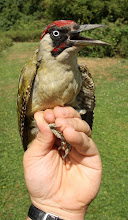I wasn't sure it was going to work, but nothing ventured nothing gained.
Having seen before how to catch Meadow Pipits and having bought new nets especially (nets of the same lenght being a requirement for this to work) I sussed out where best to put the nets the night before. It was time to test my skills.
The wind wasn't a problem when we arrived so we set about erecting nets, however the ground was very hard and it was proving difficult to put the guy poles in the ground. We found a brick and ended up bashing them in (even that was difficult!).
My ringing license permits me to use tape lures, so on went the tape and the wait started. Were there any Meadow Pipits about we wondered?
More waiting.
We went back to my car for something and on our return, hey presto - Meadow Pipits arriving, landing on the top of the net, on top of the poles and on the guy ropes! One mad dash later and..

Above: One of 3 Meadow Pipits ringed - new to my self caught list and new species ringed for the site.
With there being a lack of Meadow Pipits coming back after the first round, we put nets up elsewhere - a 30ft in amongst some plum trees (this net caught nothing but leaves and twigs!) and a 60ft in some ash regeneration near the wood with all the plum trees.
These nets weren't doing particularly well either to begin with, and going back to the Meadow Pipits, there were none so having passed the skills test it was time to concentrate on Blackcaps.
Wren - and that was it for that net round! However whilst David was extracting the Wren (that's what helpers are for after all!), my attention was drawn to an area dripping with birds (Goldfinch, Green Woodpeckers, different varieties of Tits and a species that I couldn't quite see properly to clinch the ID though I had a good idea). Wren extracted and we both looked and said - we can get a net in there between the teasels and the trees (Plum, Elder, Hawthorn etc.), so we erected a 60ft and 30ft jap net in a dog leg around the corner where all these birds were - the emphasis on were because they disappeared when we went to put the nets up!
So we left the nets alone to see what was happening. 15 minutes later and I went for a sneak peek - a few birds were in the 60ft in the ash regeneration. A net with a bird in is never bad news. A Marsh Tit was seen hanging around nearby too. Another 15 minutes later and we went back to find nearly 20 birds in that net! Mostly Blackcap, a couple of Chiff Chaffs, a Robin, a Whitethroat.
Extraction began - half way through my attention was drawn to a Green Woodpecker noisily flying out from the teasels, staying low, towards the net. Still low enough, still towards the net - RUN! I wasn't going to give this a chance to get out of the net. Approaching 2 more were already in the net!

Above: 2 Green Woodpeckers - a new species ringed for the site. Sadly, one got out of the net before I could get to it. I shall remember for the future now I know where to go to catch them! There are lots on site.
This was turning out to be a great day. A couple of Goldfinch, another Blackcap, a Long Tailed Tit and one other bird made these 2 extra nets productive.
David ringed most of the birds - I just took a Green Woodpecker and one or two others to keep me happy whilst I scribed. However the last bird from the round was for me:

Above: A juvenile Spotted Flycatcher! This is only the second species I have never ringed before and caught myself (the first being Grasshopper Warbler). Needless to say, the 3rd species new for the site on this really really great day!

Above: The Spotted Flycatcher from the front.
Having now cleared the area of the majority of birds, we were left with a few Wrens to punctuate the waiting.
We gave up eventually at around 1.30pm. Gathering up all the equipment we were walking back to the cars when my eyes caught sight of a bird that appeared to come out of a rabbit hole! This rabbit hole was in the hollow dug out by The Greensand Trust to create a bee habitat (the geology is greensand & therefore the ground is very sandy). We got the binoculars out and identified the bird but could we turn this ordinary day (ha ha) into a spectacular day?
After making sure it wasn't going to be a waste of time, a net was hastily erected and 5 minutes later (that included a bit of jumping for joy) I was ringing this:

Above: The birds 'armpit' feathers.

Above: The birds tail.

Above: I'm ring the bird. Know what it is yet?

Above: It's a Wheatear. It was carrying some fat - a bird on passage. There aren't many birds of this species that have been ringed in Bedfordshire.

Above: A happy very chappy. My 3rd self caught ringing tick, hot on the heels of number two! And the 4th new species ringed for the site in one day. A spectacular day complete.

Above: This post however, wouldn't be complete without a picture of David. Thanks for helping and I couldn't have done it without you. A learning experience for both of us.
















































